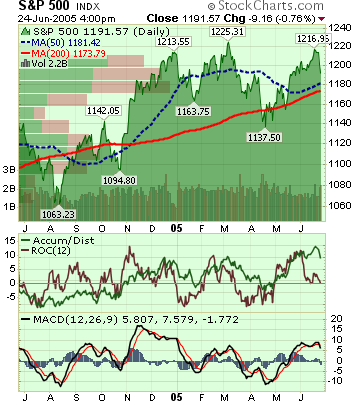Economic reports for the week include:
Mon. - None of note
Tues. - Consumer Confidence
Wed. - Final 1Q GDP, Final 1Q Personal Consumption, Final 1Q GDP Price Index
Thur. - Personal Income, Personal Spending, PCE Deflator, Initial Jobless Claims, Chicago Purchasing Manager, Help Wanted, FOMC Rate Decision
Fri. - Univ. of Mich. Consumer Confidence
Some of the more noteworthy companies that release quarterly earnings this week are:
Mon. - Cyberonics Inc.(CYBX), Nike Inc.(NKE), Walgreen Co.(WAG), Paychex Inc.(PAYX), Sonic Corp.(SONC)
Tues. - Apollo Group(APOL), BearingPoint(BE), BMC Software(BMC), Doral Financial(DRL), Emmis Communications(EMMS)
Wed. - General Mills(GIS), Monsanto(MON), Oracle Corp.(ORCL)
Thur. - American Greetings(AM), Biomet(BMET), ConAgra Foods(CAG), Constellation Brands(STZ), PalmOne(PLMO), Red Hat(RHAT)
Fri. - None of note
Other events that have market-moving potential this week include:
Mon. - Wachovia Equity Conference
Tue. - Banc of America Utilities & Gas Conference, Wachovia Equity Conference, Bear Stearns Biotech Conference
Wed. - Morgan Stanley Business and Professional Conference, Wachovia Equity Conference
Thur. - Wachovia Equity Conference, Morgan Stanley Business and Professional Conference
Fri. - F, DCX, GM Sales Conference Call
BOTTOM LINE: I expect US stocks to finish the week modestly higher. End-of-the-quarter window dressing, an end to Fed speculation and better economic data should spur stock gains next week. A reversal in oil would obviously help, as well. US stocks will likely remain mixed over the next few weeks as earnings pre-announcements come in. A stronger dollar and weakening economic conditions in Europe may adversely affect US companies with significant exposure to the region. While the current level of energy prices is having minimal direct impact on US consumer spending thus far, it is affecting the already weakened economies of other nations to a much greater degree. With China's economy becoming increasingly susceptible to a "hard-landing" and Europe on the verge of negative growth, the odds of a synchronized global slowdown are rising. I continue to believe energy prices will decline precipitously during the second half of the year as global demand slows more than most anticipate. This should have a very positive effect on US stock prices. As well, low interest rates, lower inflation, a modestly improving labor market, a flight to US assets, a strong but slowing housing market, reasonable valuations and a stable dollar should help boost equities during this time period. My trading indicators are now giving neutral signals and the Portfolio is 75% net long heading into the week.
